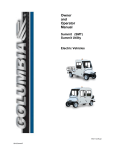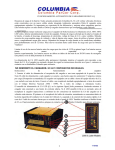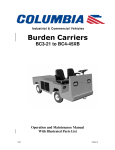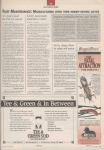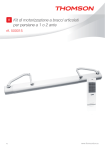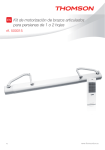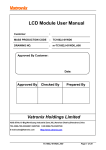Download Columbia CR-10 Chariot Operator`s manual
Transcript
Owner’s and Operator’s Manual CR-10 Chariot Electric Vehicles PN 709642-03 5/2011 Preface Welcome, and congratulations on your choice of vehicle from Columbia ParCar Corp.! Your vehicle has been designed and manufactured to conform to applicable sections of ANSI B56.8. Your safe use and operation of your vehicle is important to us. Any alteration of your Columbia vehicle that results in the vehicle being in noncompliance with applicable ANSI standards is strictly prohibited. Columbia ParCar Corp. is not responsible or liable for any damage that results from any such alteration, and all warranties for any such altered vehicles are null and void. These vehicles are not designed for over-the-road use. They do not conform to Federal Motor Vehicle Safety Standards or EPA regulations, and are not equipped for operation on public streets, roads, or highways. To the best knowledge of Columbia ParCar Corp., the material contained herein is accurate as of the date this publication was approved for printing. Columbia ParCar Corp. is not liable for errors in this manual or for incidental or consequential damages that result from the use of the material in this manual. Columbia ParCar Corp. reserves the right to change specifications, equipment or designs at any time without notice and without incurring obligation. This manual contains proprietary information that is protected by copyright. All rights are reserved. No part of this manual may be photocopied, reproduced, or translated to another language without the written consent of Columbia ParCar Corp. Columbia ParCar Corp. products are manufactured under one or more of the following U.S. Patents - 2986162, 2987934, 3116089, 3144631, 3144860, 3229792, 3434887, 3559773, 3673359, 3680403, 3683716, 3709317, 4648473, Des. 225626. 1115 Commercial Avenue • Reedsburg, WI 53959 Phone: (608) 524-8888 • Fax: (608) 524-8380 (800) 222-4653 • Web: www.parcar.com i TABLE OF CONTENTS 1.0 INTRODUCTION 1.1 SAFETY MESSAGES 1.2 VEHICLE DESCRIPTION 1.3 VEHICLE IDENTIFICATION NUMBER (VIN) 1.4 VIN MATRIX 1.5 VEHICLE SPECIFICATIONS 2.0 SAFETY 2.1 GETTING STARTED 2.2 SAFETY VEHICLE STATEMENTS 2.3 SAFETY WARNINGS 2.4 SAFETY CONCERNS 2.5 LIFTING INSTRUCTIONS 2.6 BATTERY DISCONNECT METHODS 2.7 BATTERY REMOVAL AND INSTALLATION 3.0 OPERATIONS AND CONTROLS 3.1 INSPECTING THE VEHICLE 3.2 WHAT TO DO IF YOU HAVE A PROBLEM 3.3 VEHICLE CONTROLS 3.3.1 KEYSWITCH 3.3.2 BATTERY STATE OF CHARGE METER 3.3.3 HORN BUTTON 3.3.4 CHARGER RECEPTACLE 3.3.5 LOW BATTERY RESET SWITCH 3.3.6 CHARGING STATUS LIGHTS 3.3.7 WARNING LABEL AND OPERATING INSTRUCTIONS 3.3.8 FOOT TREADLE PLATFORM 3.3.9 STEERING HANDLE BARS 3.4 VEHICLE OPERATING INSTRUCTIONS 3.4.1 DRIVING THE VEHICLE 3.4.2 PARKING 3.4.3 PRE-OPERATION CHECKLIST 4.0 ELECTRIC SYSTEM 4.1 IMPORTANT INFORMATION 4.2 BATTERY INSPECTION & MAINTENANCE 4.3 BATTERY CLEANING 4.4 CONDITIONS WHICH AFFECT CHARGING 4.5 BATTERY CHARGING 4.5.1 CHARGER INFORMATION 4.5.2 CHARGER OPERATING INSTRUCTIONS 4.5.3 LOW BATTERY RESET SWITCH 4.5.4 TROUBLE SHOOTING CHART 4.6 SPECIFIC GRAVITY TEST 4.7 TIPS FOR PROLONGING BATTERY LIFE 4.8 VEHICLE TROUBLESHOOTING 5.0 SERVICING YOUR VEHICLE 5.1 MAINTENANCE GUIDELINES 5.2 BRAKE SYSTEM 5.3 CLEANING 5.4 MAINTENANCE SCHEDULE - OWNER/OPERATOR 5.5 MAINTENANCE SCHEDULE - QUALIFIED TECHNICIAN 6.0 VEHICLE STORAGE 6.1 BATTERY PREPARATION 6.2 VEHICLE PREPARATION 6.3 RETURNING VEHICLE TO SERVICE ii NOTICE: In an effort to streamline product support, please ensure your vehicle is properly registered with Columbia ParCar. Registration allows for more effective product support including product updates and warranty processing. Please consult with your servicing dealer to verify or complete the registration process. DATE 5/9/2011 CHANGE HISTORY DESCRIPTION Issued – separated from Parts & Service iii BY TB 1.0 INTRODUCTION This manual provides important safety information, operating instructions, model specifications and maintenance instructions for the CR-10 Chariot. The information in this manual is limited to care and maintenance information only. Information covering repairs and technical service is provided in detailed service manuals available from Columbia Dealers. These activities require the attention of a skilled technician and the use of special tools and equipment. Your Columbia Dealer has the facilities, experience and genuine Columbia vehicle parts and accessories to properly service Columbia vehicles. 1.1 SAFETY MESSAGES Safety messages and other information in this manual are preceded by the words DANGER, WARNING, CAUTION or NOTICE. They are printed in bold face, and are very important. We recommend you take special notice of this information. Danger indicates a hazardous situation which, if not avoided, will result in death or serious injury. Warning indicates a hazardous situation which, if not avoided, could result in death or serious injury. Caution indicates a hazardous situation which, if not avoided, could result in minor or moderate injury. NOTICE: Notices are messages not related to personal injury. They will provide key information to prevent property damage and to assure procedures are more easily understood or implemented. 1.2 VEHICLE DESCRIPTION The Chariot is a single passenger vehicle involving stand-up operation. This vehicle is designed to be driven on smooth surfaces in and around industrial plants, nurseries, institutions, motels, mobile home parks, and resorts. This vehicle is not designed to be driven on public highways. It is designed to conform to requirements for Type E vehicles as described in O.S.H.A. Standard Section 1910.178 (Powered Industrial Trucks) and with all applicable portions of the American National Standard for Personnel and Burden Carriers (ANSI B56.8 1993 Part III). 1.3 VEHICLE IDENTIFICATION NUMBER (VIN) Each vehicle is assigned a unique Vehicle Identification Number (VIN). The VIN describes facts and features of the vehicle and contains thirteen (13) digits. The VIN can be found in two locations. The VIN is recorded on the vehicle nameplate which is located on the left side of the operator’s position. See Figure 1.3.1. The nameplate also has other important information such as vehicle weights and capacity. Do not exceed this capacity. This rated capacity includes cargo and operator. Figure 1.3.1 1-1 The VIN is also stamped on the metal cross bar located under the foot treadle platform. See Figure 1.3.2. To ensure prompt service when repairs or adjustments are required, your Columbia Dealer must have the VIN. Figure 1.3.2 CR1A1-0ZG1234 is an example of a current VIN. For your own personal reference, fill in the VIN in the space provided below. 1.4 VIN MATRIX 13 DIGIT VIN – USED AFTER FEBURARY 2006 CR1 (CR-10 Chariot) A = Series, Resistor 1 = 12V - = normal # = Special Product 0 = Not Applicable Z = Rear Mechanical H = 2009, J = 2010, K = 2011 etc. (Letters I & O not used)* 1234 Digit 1 thru 3 = Abbreviation (Model) Digit 4 = Power System Digit 5 = System Voltage Digit 6 = VIN Spacer Digit 7= Controller Amperage Digit 8 = Axle/Brake System Digit 9 = Build Year Digit 10 Thru 13 – Build Sequence 1.5 VEHICLE SPECIFICATIONS Passenger Capacity 1 Max. Speed (MPH) 9 Turning – Curb to Curb (in) 79 Turning –Intersecting Aisle (in) 41 Overall Length (in) 52 Overall Width (in) 29.5 Overall Height (in) 44 Wheelbase (in) 36 Load Bed Height (in) 24 Load Bed – LxW (in) 18x16 Tires 4.80x8, Pneumatic, 6 ply, Load Range C 4.80x8, Foam Filled, 6 ply, Load Range C 1-2 2.0 SAFETY 2.1 GETTING STARTED For personal safety, before operating the vehicle, it is the operator’s responsibility to read, understand and follow the basic rules of operation and maintenance instructions in this manual. If you are responsible for the use of the vehicle, it is your responsibility to inform the person or persons using the vehicle about the following basic rules of operation for their personal safety. It is Columbia ParCar Corporation’s specific recommendation that the following warnings must be observed at all times. Not all are repeated throughout this manual, but the recommendations included must be observed whenever these subjects (indoor vehicle operation hazards, battery hazards, etc.) are encountered. Section 4.0 ELECTRIC SYSTEM contains important safety and other system information. 2.2 SAFETY VEHICLE STATEMENTS Any modifications or changes to the vehicle that affect the stability, steering or that results in increased speed beyond factory specifications could result in vehicle damage, severe personal injury or death. Only trained service professionals should repair or service this vehicle. Persons doing even simple repairs or maintenance should have working knowledge and experience in general electrical and mechanical repair. Follow all procedures exactly and observe all safety messages stated in this manual. Working on vehicles without following proper procedures and using proper equipment may result in vehicle damage or personal injury. See Section 2.3 OPERATOR SAFETY INSTRUCTIONS. Moving parts hazard! When operating any vehicle in a stationary position, avoid components which could snag clothing or cause sever injury to body parts. A running vehicle must be worked on with the greatest care. Failure to maintain vehicle properly could result in decreased vehicle performance, reliability or cause severe personal injury. Always wear safety glasses or approved eye protection while performing vehicle maintenance. This vehicle is not Federal or State DOT approved and is not equipped to be operated on public roads or highways. Do not exceed the rated vehicle speed. Exceeding this speed may result in steering difficulty, motor damage, and/or loss of control and injury When replacement parts are required, use only genuine Columbia Vehicle parts. No modifications or additions, which affect the mechanical or electrical integrity and the safe operation of the unit, shall be made without the written approval of the manufacturer. If in doubt about any modification, contact your local Columbia Dealer or Columbia ParCar Corp. Customer Service. Do not overload the vehicle. Never exceed maximum payload as specified on the vehicle nameplate. See Section 1.3, Figure 1.3.1. 2-1 Your safety and the safety of others depend on your safe operation and maintenance of this vehicle. Prior to operation, you, the operator, must be thoroughly familiar with this and all other sections of this manual. 2.3 SAFETY WARNINGS For personal safety and to maintain stability and control, operate this vehicle under these conditions only. Failure to comply with these warnings may result in bodily injury and property damage. Do not drive this vehicle unless you are a qualified and trained operator and familiar with the vehicle operational controls. Never exceed the capacity ratings of the vehicle. Exceeding these limits may endanger occupant or cause vehicle damage. Completely stop vehicle before stepping off. If vehicle is to be left unattended, turn keyswitch to “OFF” and remove key. Do not use accelerator to hold vehicle on an incline. Use brake. Do not change the directional keyswitch while vehicle is moving. Drive slowly in turns and up and down grades. Do not make turns on steep hills or inclines. Do not operate while under the influence of alcohol or drugs. To avoid the risk of injury or vehicle damage, operate at maximum speed only on smooth flat surfaces. Allow additional stopping distance when traveling at higher speeds. Do not drive this vehicle in hazardous areas unless this vehicle is approved and labeled for such operation. Keep a safe distance when following other vehicles and from the edge of ramps and platforms. Immediately report any accident or vehicle problem to your supervisor. 2.4 SAFETY CONCERNS It is recommended that the operator and owner or renter of this vehicle comply with the OSHA requirements as stated in the Code of Federal Regulations, Section 29, 1910.178, Powered Industrial Truck Training Standard and the ANSI requirements as stated in Personnel and Burden Carriers ANSI B56.8. As a minimum every operator should, in addition to the above requirements found in the standards noted above: Demonstrate a working knowledge of each control. Understand all safety rules and guidelines as presented in this manual. Know how to properly load and unload cargo. Know how to properly park the vehicle. Recognize an improperly maintained vehicle. Demonstrate ability to handle the vehicle in all conditions. Every owner or renter of this vehicle must, at a minimum: Define where the vehicles should and should not be driven and utilized. Ensure all proper warnings as to driving hazards are properly displayed and visible. Install safety signage concerning hills, speed bumps, ramps, turns, blind crossings, intersections, etc. Define who should and who should not drive the vehicles. Enforce safe driving and operating rules. Provide driver training for first time operators and review safe operating recommendations regularly. Maintain vehicles in a safe operating condition and maintain a schedule for daily, weekly, monthly, quarterly, semi-annually and annual vehicle inspections. Determine who, when, and how should pre-operation inspections be conducted. Notify operators what should be done if an unsafe condition or operating problem is discovered. 2-2 2.5 LIFTING INSTRUCTIONS Use extreme caution lifting or working on or around lifted vehicle. Vehicle should be on a flat, hard and level surface. When lifting the vehicle for service, remove key and use a sturdy lifting device such as a hoist or floor jack placed under the Chariot body. Always block wheels to prevent it from rolling. After the body is lifted 4 to 6 inches from the floor, place a suitable device under vehicle frame to support vehicle weight. An example is a 4” x 6” wooden block. If vehicle is raised while loaded, check that the load is secured before lifting. Failure to do so could cause damage to the vehicle, the load or cause personal injury. 2.6 BATTERY DISCONNECT METHODS Figure 2.6.1 illustrates the battery configuration. Disconnect both leads before performing any maintenance. Figure 2.6.1 2.7 BATTERY REMOVAL AND INSTALLATION Remove battery negative (-) cable. Remove battery positive (+) cable. Remove battery hold down. Remove batteries from vehicle. To install batteries, reverse the removal procedure with the negative (-) cable being attached last. 2-3 3.0 OPERATIONS AND CONTROLS 3.1 INSPECTING THE VEHICLE Upon receipt of vehicle, perform a pre-delivery inspection of the vehicle. Also, before using the vehicle, there are checks that must be performed to ensure that it is in safe proper working order. NOTICE: Vehicle should be inspected immediately after delivery. Use the following guidelines to make sure there are no obvious problems. Examine the contents of all packages and accessories that may have come in separate packages with this vehicle. Make sure everything listed on the packing slip is there. Items should not be broken or damaged. Examine any visible wiring for obvious signs of damage. Check that all connections are secure. Check that battery connections are tight and all cells are filled to above plates. Check for damaged or leaking batteries. Inspect the tires for obvious wear or damage. Check for proper tire inflation. Refer to manufactures recommendation imprinted on tire sidewall. Make sure that all wheel lugs are secure. Check the body and other parts for obvious damage. Look for body damage, jagged edges etc. that may cause personal injury. Operate each of the following controls before turning on the power keyswitch. Foot Treadle Steering Handle Bar NOTICE: Each control should operate smoothly and easily without sticking or requiring excessive effort. Check that the horn sounds and that the key can only be removed when keyswitch is in the “OFF” position. 3.2 WHAT TO DO IF YOU HAVE A PROBLEM If vehicle has just been delivered, report any physical damage or missing items to the shipping company and your local Columbia Dealer. Report any service issue problems to the individual(s) responsible for correction and/or repair or contact your local Columbia Dealer for service. If any problems are found, Do not operate vehicle until repairs are made. Failure to make necessary repairs could result in fire, severe personal injury, property damage or death. Consult your local Columbia Dealer for professional service. 3-1 3.3 VEHICLE CONTROLS This section describes the operating controls of the vehicle. Figure 3.3.1 identifies the locations of many of these controls. G H F A E B D C Figure 3.3.1 3.3.1 KEYSWITCH – Figure 3.3.1 Arrow A The keyswitch energizes the vehicle. Rotate the key to the right from vertical to turn the vehicle on, return to vertical to turn the vehicle off. If equipped, the keyswitch can also have a reverse direction. Rotate the key to the left from vertical to move in reverse (REV). NOTICE: Do not shift from forward to reverse or vice-versa while the vehicle is in motion. Make sure the vehicle is completely stopped before changing direction. To avoid injury, speed in reverse should always be kept at a minimum. The keyswitch should be in the vertical OFF position whenever the operator leaves the vehicle. The switch is also designed to secure and disable the vehicle. You can remove the key only when the key switch is in the OFF position. 3.3.2 BATTERY STATE OF CHARGE METER - Figure 3.3.1 Arrow B The battery state of charge meter is an analog gauge with an indicating needle and a colored background. It is a continuously reading meter. At rest with fully charged batteries the meter should read in the right white region. 3-2 When accelerating quickly, the needle will move to the left green region near the very far left red region. This is normal. If the needle continues past the green region into the very far left red region, it indicates that the batteries need recharging as soon as possible to avoid a shut-down of the vehicle. 3.3.3 HORN BUTTON – FIGURE 3.3.1 Arrow C The horn button is located on the left inside body panel and may be sounded by applying lateral pressure with the operator's left leg. 3.3.4 CHARGER RECEPTACLE – Figure 3.3.1 Arrow D The charger receptacle is for battery charging using the supplied AC cord. 3.3.5 LOW BATTERY RESET SWITCH – Figure 3.3.1 Arrow E The Low Battery Reset Switch is used if the battery is heavily over discharged. See Section 4.5.3. 3.3.6 CHARGING STATUS LIGHTS– FIGURE 3.3.1 Arrows F These lights indicate the battery charging status. 3.3.7 WARNING LABEL and OPERATING INSTRUCTION - Figure 3.3.1 Arrows G & H Read the warning label and operating instruction information carefully before operating the vehicle. Do not remove any nameplate, warnings, or instructions affixed to your Columbia Vehicle. Promptly replace any that become damaged or removed. Contact Columbia ParCar for replacements. 3.3.8 FOOT TREADLE PLATFORM – Figure 3.3.2 Arrow A The foot treadle platform controls acceleration and braking. By slowly tilting the treadle forward (weight on toes) the accelerator is engaged and vehicle moves forward. By tilting the treadle backward (weight on heels) the brake is applied. A NOTICE: Do not stomp down on the rear of treadle. The parking brake is spring loaded to set automatically when leaving the vehicle and is automatically disengaged by tilting the treadle forward. Figure 3.3.2 3.3.9 STEERING HANDLE BARS – NOT SHOWN The steering system is designed to operate as a bicycle does. The vehicle will turn to the same direction as the handle bar. Be sure to have both hands on the handlebars at all times. Do not turn the vehicle sharply at high speeds. 3-3 3.4 VEHICLE OPERATING INSTRUCTIONS 3.4.1 DRIVING THE VEHICLE Do not operate vehicle unless you are a qualified and trained operator. Keep the vehicle under control at all times. Drive only on level surfaces or on surfaces having an incline of no more than 10%. Drive slowly when making a turn, especially if the ground is wet, slippery or when driving on an incline. Do not drive this vehicle in hazardous areas unless this vehicle is approved and labeled for such operation. Do not drive over loose objects, holes or bumps. Observe all traffic regulations and speed limits. Keep to the right of traffic under normal conditions. Maintain a safe distance from all objects and other vehicles. Yield right of way to pedestrians, ambulances, fire trucks or other vehicles in emergencies. Do not overtake another vehicle at intersections, blind spots or other dangerous locations. Keep a clear view ahead at all times. Slow and sound the horn when approaching a corner or other blind intersection. Immediately report any accident or vehicle problem to your supervisor. Do not load cargo that can easily fall off this vehicle. Do not exceed the cargo load capacity of this vehicle. 3.4.2 PARKING If you will be away from this vehicle turn off the keyswitch, remove the key and take the key with you. If you park this vehicle on an incline, block the wheels. Do not block fire aisles, fire equipment, or stairways. 3.4.3 PRE-OPERATION CHECKLIST Before operating the vehicle always inspect the items listed in the following checklist. Should any item malfunction or need adjustment. Do not operate vehicle until the problem has been corrected. ITEM PROCEDURE Fully charged or adequately charged to provide power for duration of operations. The AC cord is disconnected from the vehicle. Batteries Electrolyte level in each cell covers the top of cell plates. Batteries are secure and free of corrosion. All terminals and connections are tight. Tire Pressure Inflated to the specifications labeled on the tire sidewall. Horn Press horn button to sound horn. Treadle Operates smoothly Labels All warning and operation labels in place. Steering Responsiveness and the absence of excessive free play. Cargo Secured to the bed platform. Load is balanced and not top heavy. Obstacles Path of intended travel is free for obstructions. 3-4 4.0 ELECTRIC SYSTEM 4.1 IMPORTANT INFORMATION The type of battery used in a Columbia vehicle has a service requirement which is quite different from that of an automotive battery. The electric vehicle battery supplies all of the power to drive the vehicle. During operation the power stored in the batteries is expended. While the amperage drain rate can vary greatly depending on the type of service, the duration of use and the number of "starts" and "stops" made during a day, the batteries nevertheless progress through each duty cycle from "fully charged" to an almost depleted state. This type of service is known as "deep cycle" service and electric vehicle batteries are specifically designed to handle this type of service. Proper performance of your Columbia Vehicle can only be obtained from specified deep cycle, electric vehicle batteries. PLEASE REVIEW IMPORTANT DANGER STATEMENTS WHEN WORKING AROUND BATTERIES AND CHARGING SYSTEMS! Always remove key and disconnect batteries before servicing or repairing the vehicle (Section 2.6). Always wear full-face shield when working on or near batteries. All batteries used in electric vehicles can explode! Batteries produce explosive hydrogen gas at all times, especially, during charging or discharging. Ventilate area when charging batteries. Do not attempt to charge a battery if it is frozen, or if the case is bulged excessively. Frozen batteries can explode! Properly dispose of the battery. Do not smoke around batteries. Keep sparks and flames away from batteries and the charging area. When working around or servicing batteries use care to prevent an accidental arc which could cause an explosion. Use only approved insulated tools, remove jewelry such as rings, watches, chains etc. and place an insulating material (wood, plastic, rubber etc.) over all battery connections. If any problems are found during scheduled maintenance or inspections, do not operate vehicle until repairs are made. Failure to make necessary repairs could result in fire, property damage, severe personal injury, or death. Battery acid is poisonous and can cause severe burns. Avoid contact with skin, eyes, or clothing. ANTIDOTES EXTERNAL: Flush with water. Call a physician immediately. INTERNAL: Drink large quantities of milk or water. Follow with milk of magnesia or vegetable oil. Call a physician immediately EYES: Flush with water for fifteen minutes. Call physician immediately. 4-1 NOTICE: Automotive batteries should never be used for "deep cycle" application, as their useful life will be very short. Install surge arrestors on incoming AC power lines. Surge arrestors will help protect electrical/electronic components in the charger and vehicle from all but direct or “close proximity” lightning strikes. Damaged or corroded battery terminals should be replaced or cleaned as necessary. Failure to do so may cause overheating during operation. Do not attempt to recharge batteries with a charger not designed for your vehicle. Only trained technicians should service the CR-10 charger. Contact your Columbia Dealer for assistance. 4.2 BATTERY INSPECTION & MAINTENANCE Check the electrolyte level on new batteries before they are put into service, and, at a minimum, once a week thereafter. Water use increases as batteries age. See Figure 4.2.1. Never allow the electrolyte level (A) to fall below the top of the plates (C). If the plates are exposed, add only enough to cover the plates before charging. After batteries are fully charged, fill cells to just below the bottom of the cell vents (B). Electrolyte level should not touch the bottom of the cell vents. Figure 4.2.1 Do not overfill batteries. Electrolyte expands and can overflow during charging. Water added to replace the spillage dilutes the electrolyte and reduces its specific gravity. Use only distilled water. Vehicle batteries may use up to 16 quarts of water during their useful life and non-distilled water may contain harmful minerals which will have a cumulative adverse effect on battery performance and life. Batteries and connections must be clean and dry. See Section 4.3. Be sure battery hold downs are properly tightened. A loose hold down may allow the battery to become damaged from vibration or jarring. A hold down that is too tight may buckle or crack the battery case. Weekly inspect battery posts, clamps and cables for breakage, loose connections and corrosion. Replace any that are damaged. Check to see that battery cap vent holes are clear. Plugged vent holes will not permit gas to escape from the cell and could result in battery damage. 4-2 4.3 BATTERY CLEANING Acid-soaked dirt on the battery terminal connections causes current leakage, reduces battery efficiency, and battery life. Check that all vent caps are tightly in place before washing. Hose wash battery terminal connections periodically with clean low-pressure water to keep them free of acid spillage, dirt, and other debris. Do not hose wash switches, solenoids and other electrical control devices. Cover as necessary to prevent splashing. Clean battery terminal connections with baking soda (sodium bicarbonate) and water solution (5 teaspoons baking soda per quart water) and stiff bristle brush. Rinse with clean water and dry with a clean cloth. Do not allow solution to enter cap vent holes. NOTICE: Follow local ordinances and codes for proper disposal of battery cleaning waste. 4.4 CONDITIONS WHICH AFFECT CHARGING Always schedule enough charging time to allow the batteries to become fully charged. Charging time is affected by age and battery condition, state of discharge, electrolyte temperature, AC line voltage, and other variables. Correct charging methods extend battery life and vehicle range between charges. New batteries need up to four hours more charging than “mature” batteries. Before the first use, completely charge new batteries. Charging time will vary based on conditions noted above but will probably be 6 to 10 hours. If vehicle is used only occasionally, a refresher charge should be given prior to using. Battery efficiency is affected by temperature. If the temperature of the outside air and/or batteries is below 60º F, battery capacity is reduced. Batteries will require more frequent and longer charge periods in early spring, fall and winter. As batteries age, they finish charge at progressively higher charge rates and tend to use more distilled water. At this point in battery age, charger will automatically begin reducing charge time. Batteries found defective must be replaced. All batteries in a vehicle should be matched according to age, capacity and brand. 4.5 BATTERY CHARGING 4.5.1 CHARGER INFORMATION The built-in battery charger is custom made for Columbia vehicle CR-10 Models. Its operation is totally automatic. When connected to a 110 - 120 Volt AC power source, the charger's electronic timer will turn the charger on. It determines and provides the energy necessary to return batteries to a fully charged state, automatically shutting off when the batteries are fully charged. This occurs when each cell reaches approximately 2.5 volts. 4.5.2 CHARGER OPERATING INSTRUCTIONS Plug 120 volt AC supply cord into charger receptacle on charger panel. After a short time delay of approximately 5 to 6 seconds, a RED light comes on indicating battery charging. When the solid state circuitry senses that the batteries are fully charged, the RED light turns off and the GREEN light turns on indicating that charging is complete. The GREEN light will remain on until the AC cord is disconnected. At that point the light will turn off and the charger will reset itself for the next charging cycle. 4-3 4.5.3 LOW BATTERY RESET SWITCH: This is used if the batteries are heavily over discharged. When the AC cord is connected, the RED light will turn on but will shortly turn off. To reactivate the charger, push the reset button for 10 seconds. This will restart the charger. Release the button and the charger will continue to charge. 4.5.4 TROUBLE SHOOTING CHART Symptom No transformer hum Transformer hums, ammeter deflection but no AC fuse keeps blowing Charger output low or battery not getting charged Charger not shutting off Repair or Replace AC Fuse AC Input Cord Loose wires on auto-start control Primary of transformer Auto-start control DC fuse DC connector shorted or open diode Defective ammeter Shorted AC cord Shorted primary of transformer Defective capacitor Resonant of transformer Open diode Loose wires on auto-start Defective auto-start 4.6 SPECIFIC GRAVITY TEST It is possible to determine a battery's ability to perform by measuring the specific gravity (sp. gr.) of each cell with a hydrometer. This is the best method to determine a defective battery. The hydrometer readings indicate two things: State of Charge - The amount of electrical power stored in the battery. Condition - The ability of battery to store and deliver power. NOTICE: Batteries should be fully charged before performing specific gravity tests to determine battery condition. Hydrometer tests of batteries not fully charged are misleading and inconclusive. There are different type hydrometers. Carefully read and follow the instructions supplied with your hydrometer. 4.7 TIPS FOR PROLONGING BATTERY LIFE To prolong battery life, recharge batteries as soon as they become 20% or more discharged (less than 1.238 sp. gr.). Batteries may be recharged if vehicle has been driven 15 minutes or more since the previous charge. Do not allow batteries to fall below 80% discharge (1.098 sp. gr.). Deep discharging significantly reduces battery life. Opportunity charging during breaks or shift change can be used to extend range but always complete a full charge cycle at least once a day. If the vehicle is not operated daily the Power keyswitch should be turned off. This will reduce power loss on the batteries. Batteries in storage may self discharge and should be recharged when the specific gravity falls below 1.238 sp. gr. NOTICE: Specific gravity readings are at 800F. Values need adjustment for electrolyte temperature. Reduce .004 for every 100F below 800F. Increase by that amount for every 100F above 4-5 4.8 VEHICLE TROUBLESHOOTING PROBLEM CHECK Keyswitch on. Keyswitch is in desired direction. Keyswitch for loose wires or faulty switch. Will not move Batteries for loose terminals, corrosion, electrolyte level or state of charge. Motor for loose wires, open circuits. Batteries for loose terminals, corrosion, electrolyte level or state of charge. Brakes dragging Runs slow Under inflated or flat tires. Wheels for binding, do not spin freely. If these test procedures do not resolve your vehicle problem, contact your Columbia Dealer for service. 4-6 5.0 SERVICING YOUR VEHICLE 5.1 MAINTENANCE GUIDELINES To ensure that the vehicle is kept in a safe and correct operating condition, it must be inspected and maintained on a regular basis. Proper lubrication, electrical control adjustments, safety feature checks, etc. performed at recommended intervals will help prevent damage or failure of the unit while providing optimum performance. Follow the guidelines below to assure proper maintenance. Allow only trained maintenance personnel to maintain, repair, and inspect the vehicle. Before starting any repairs or maintenance, immobilize the vehicle by turning the power keyswitch off and removing the key. Disconnect both of the main battery pack leads before working on or disconnecting any electrical component or wire. Block the chassis with jack stands before working under a raised vehicle. Conduct vehicle performance checks in an authorized area where a safe clearance exists. Before starting the vehicle, follow the recommended safety procedures in Chapter 2, (SAFETY). Avoid fire hazards and have fire protection equipment present in the work area. Do not use flammable fluids for cleaning parts. Work in a properly ventilated work area. Regularly inspect and maintain in safe working condition the brakes, steering mechanisms, speed and directional control mechanisms, warning devices, guards and safety devices. Keep the vehicle in a clean condition to minimize fire hazards and facilitate detection of loose or defective parts. 5.2 BRAKE SYSTEM The mechanical brakes consist of two rear drum brakes. With no force applied to the treadle, brakes are properly adjusted when the back edge the treadle is approximately even with the top edge of the rear frame crossbar. See Figure 5.2.1. Figure 5.2.1 To adjust the brakes (See Figure 5.2.2): Loosen jam nut (Arrow A) on upper end of the treadle to brake linkage. Turn (lengthen) upper brake linkage (Arrow B) and check adjustment. Once properly adjusted and tighten the jam nut. A NOTICE: Minimum brake shoe lining thickness is .080 inches. B Figure 5.2.2 5-1 5.2 CLEANING Wash underside to remove all dirt and debris. Do not direct high pressure water at the speed switch or tops of the batteries. Wash body and seat with a mild detergent. Do not use abrasives (bodies are painted). Frequent washings with mild soap will preserve the finish of your vehicle. For stubborn and imbedded dirt, a soft bristle brush may be used. Tar, asphalt, creosote and the like should be removed immediately to prevent staining of paint. NOTICE: Do not use harsh detergents, abrasives or cleaning solvents that contain ammonia, aromatic solvents or alkaline material to clean cab. Lug nuts tight. * Check tire pressure, wear, damage. Dented rims. * SemiAnnual Operation Monthly Item Weekly 5.3 MAINTENANCE SCHEDULE - OWNER/OPERATOR Tires Electrical Brakes Body and Frame Lube Check electrolyte level. * As required, clean battery terminals and wash cases. * Check the general condition of the electrical system (connections, frayed/broken cables). * Adjust. * Inspect for loose hardware (bolts & nuts). * Clean body and seats, Wash as needed. * Wash engine/motor compartment and undercarriage. * Oil movement points (body hinges, brake mechanisms and linkage, leaf spring bushings etc.). 5-2 * 5.4 MAINTENANCE SCHEDULE - QUALIFIED TECHNICIAN Drive Electrical Brakes Control Speed Lube Steering Check treadle adjustment, motor mounting hardware, and drive chain adjustment Test batteries Inspect motor condition and operation. Inspect brakes – clean, adjust, replace as needed. Adjust brakes Lubricate Check contact bars for wear, spring tension Rear wheel bearings, grease or replace Annual * * * * * * * * Repack front wheel bearings Check front wheel bearing adjustment * Check fork spindle bearing adjustment * 5-3 SemiAnnual Quarterly Operation Monthly Item Weekly It is recommended that the following be performed by a trained qualified technician or your Columbia Dealer * 6.0 VEHICLE STORAGE (over 6 weeks) 6.1 BATTERY PREPARATION Before storage make sure batteries are fully charged and the electrolyte is full in all cells per Section 4.2. Clean the batteries and connections per Section 4.3. Recharging will be necessary during storage. Frequency for recharging is as follows: STORAGE TEMPERATURE 0 CHARGE AT 0 Below 4 C (40 F) 0 0 0 Every 6 months 0 4 C - 16 C (40 – 60 F) Every 2 months 0 Once a month 0 Above 16 C (60 F) The specific gravity of the electrolyte should be checked every 6 to 8 weeks using a hydrometer. See Section 4.6. The batteries should be recharged as necessary to a specific gravity of approximately 1.260 sp. gr. After charging, disconnect the batteries. See Section 2.6. Batteries in a low state of charge will freeze at higher temperatures than fully charged batteries. Do not attempt to charge a battery that is frozen or if battery case is excessively bulged. Frozen batteries can explode. Properly dispose of the battery. Table C indicates freezing points of batteries at different specific gravities. TABLE C FREEZE POINT OF/OC -70/-57 -39/-38 -16/-26 -2/-19 +17/-8 SPECIFIC GRAVITY 1.260 1.230 1.200 1.117 1.110 NOTICE: Specific gravity readings are at 800F. Values need adjustment for electrolyte temperature. Reduce .004 for every 100F below 800F. Increase by that amount for every 100F above 6.2 VEHICLE PREPARATION Store the vehicle in a cool place. Maintain tire pressure at sidewall recommendation. Clean vehicle body, battery compartment and vehicle underside. Block wheels to prevent movement. NOTICE: Make sure keyswitch is in the OFF position. 6.3 RETURNING VEHICLE TO SERVICE If necessary, connect the battery pack and fully recharge batteries. Check tire pressure and readjust if necessary. Perform the pre-operation checks per Section 3.4.4. 6-1 1115 Commercial Avenue • Reedsburg, WI 53959 Phone: (608) 524-8888 • Fax: (608) 524-8380 (800) 222-4653 • Web: www.parcar.com
























